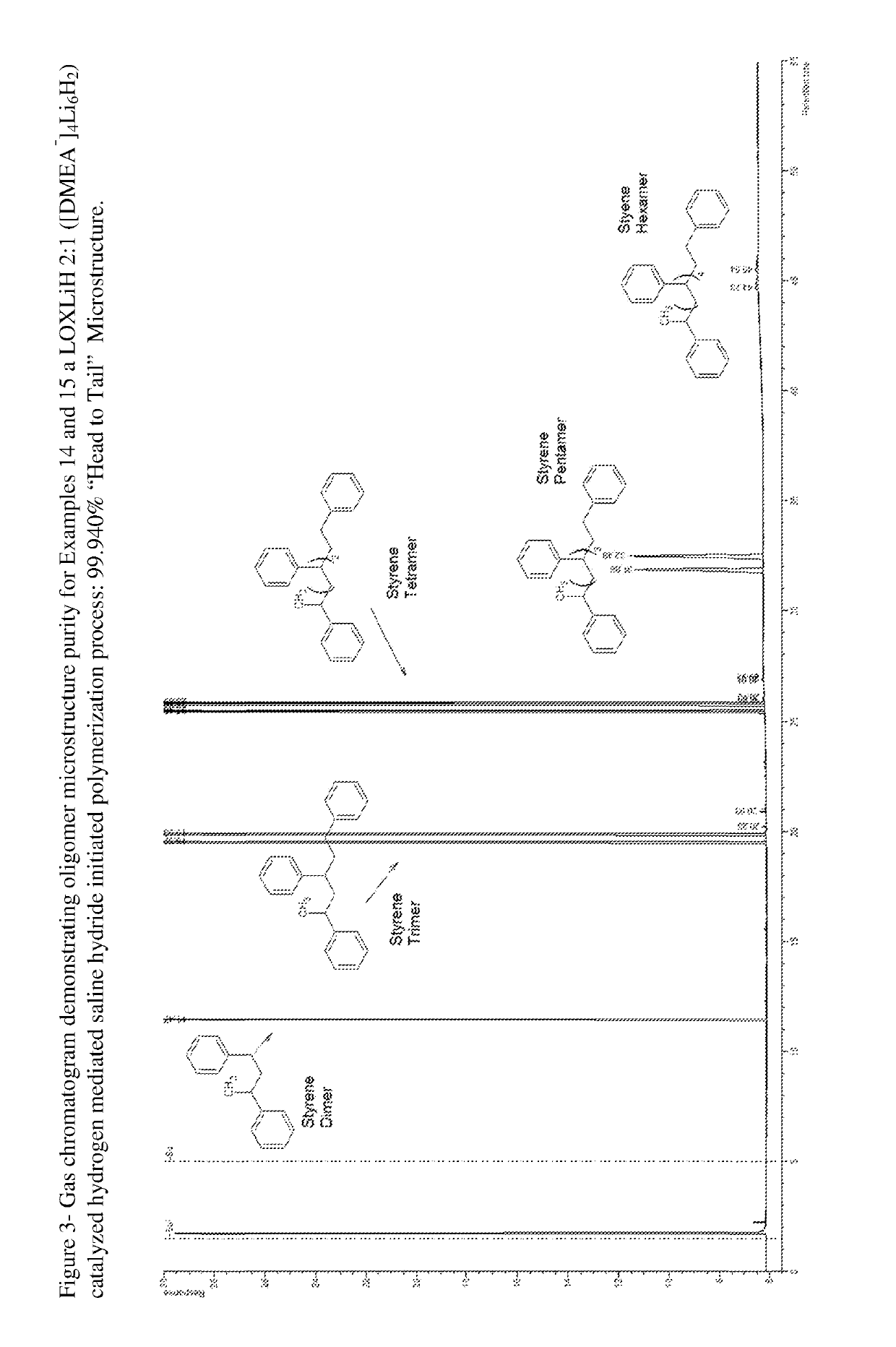Process and hydrocarbon soluble saline hydride catalyst for hydrogen mediated saline hydride iniated anionic chain transfer polymerization and polymer distribution compositions produced therefrom
a technology of anionic chain transfer and hydrogen saline hydride, which is applied in the field of process and hydrocarbon soluble saline hydride catalyst for hydrogen mediated saline hydride iniated anionic chain transfer polymerization and polymer distribution compositions produced therefrom, can solve the problems of poor regioselectivity of monometallic tmeda butyllithium catalyst forming reagents with regard to the metalation of eth
- Summary
- Abstract
- Description
- Claims
- Application Information
AI Technical Summary
Benefits of technology
Problems solved by technology
Method used
Image
Examples
examples
General Apparatus Used
[0228]The apparatus used for HMSHIP processes is as follows. A 316 stainless steel 2-liter Parr autoclave having thermal couple, bottom drain valve, cooling coils, hot oil jacket and either two or three or four pitch-blade turbine impellers (with placement of each impeller as noted below and specified in the Examples) was further equipped with a piston pump, a diaphragm pump, nitrogen purged 250 ml stainless charge vessel, a well calibrated high pressure metering pump and a 1 / 16th inch OD subsurface monomer feed line having either a 0.02″, or a 0.01″ or a 0.007″ ID terminal section (as noted or as otherwise noted in the Examples). The magnetic drive on the agitator is connected to a high speed air driven motor and generally operated (unless otherwise noted in the Examples) such that the stirrer impellers spin at a rate of 1130±25 RPMs during the polymerization. The autoclave is vented to an oil bubbler and / or to a 6-liter oil jacketed creased wash vessel having...
examples 1-24
[0235]The experimental details of Examples 1-24 (reaction conditions, reagent charges, and initial as well as final catalyst concentration), scale-up parameters (relative feeds and relative hourly feed rates) and results (polymer molecular weight distribution [MWD] as determined by GPC and polymer yield) are presented in tabular form in Tables III-VI. It should be clear that the LOXSH catalyst and polymerization reaction conditions of this invention provide countless combinations of the reagents from which they are synthesized and the reaction parameters under which a process is conducted. Thus Examples 1-5 and Examples 6-13 comprise the initial scoping experiments designed to explore this novel catalyst system and reaction conditions. Accordingly these Examples only utilized about 25% to 50% of the preferred amount of monomer per experiment. With the reduced amount of styrene monomer employed, impeller configuration II was employed. Therefore except for the placement of the impelle...
example 3
Representative of 25% of Full Monomer Feed Volume LOXLiH ca. [DMEA−]5Li12H7 Catalyst at 80° C.
[0236]Anhydrous cyclohexane, 345 ml of 495 ml (384.9 g) was charged to the reactor at 25° C. under a dry hydrogen (0 PSIG H2) atmosphere. To the stirred solvent (800 RPM, three pitched blade turbines with Configuration II above) was charged through the charge vessel via positive nitrogen pressure, a solution previously formed from 2.27 g (0.0255 mol.) N,N-dimethylethanolamine, 134.7 g (1.27 mol) ethylbenzene and 12.22 g (0.105 mol) of TMEDA. The charge vessel and transfer line to the reactor was flushed with a 50 ml portion of anhydrous cyclohexane from the total amount above. Next, 30.37 ml (0.0607 mole) 2.0 M n-butyllithium was transferred through the charge vessel to the reactor followed by two 50 ml aliquots of the anhydrous cyclohexane from the total amount above. During the organolithium charge agitation speed was increased to 1130 RPM and consequently the reactor pressure decreased t...
PUM
| Property | Measurement | Unit |
|---|---|---|
| pKa | aaaaa | aaaaa |
| pKa | aaaaa | aaaaa |
| temperature | aaaaa | aaaaa |
Abstract
Description
Claims
Application Information
 Login to View More
Login to View More - R&D
- Intellectual Property
- Life Sciences
- Materials
- Tech Scout
- Unparalleled Data Quality
- Higher Quality Content
- 60% Fewer Hallucinations
Browse by: Latest US Patents, China's latest patents, Technical Efficacy Thesaurus, Application Domain, Technology Topic, Popular Technical Reports.
© 2025 PatSnap. All rights reserved.Legal|Privacy policy|Modern Slavery Act Transparency Statement|Sitemap|About US| Contact US: help@patsnap.com



